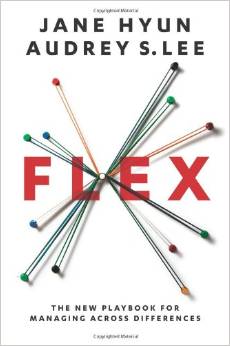Prominent executive coaches and leadership strategists Jane Hyun and Audrey S. Lee offer lessons on the vital skill of “Flexing” — the art of flexing your personal leadership style to more effectively lead people who are different from you. Creating flex in a company’s management style will impact all aspects of developing the talent you have, attracting future talent and building relationships with customers in this competitive marketplace.
The authors outline the new challenge as understand the varying needs of those who bring a different lens to working in your environment.
- understand the power gap—the social distance between you and those in the workplace of different cultures, ages, and gender;
- stretch your management style and bridge the gap with more effective communication and feedback tools; and
- multiply the effect by teaching these skills to others and closing the power gap with clients, customers, and partners to create innovative solutions.
FLEX offers proactive strategies for managers to navigate and leverage diversity effectively showing managers how to flexi their management style by stretching how they work and communicate with others, and bridge the gap with more effective communication, feedback tools and building healthy teams; and multiply the effect by teaching these skills to others and closing the power gap with clients, customers and partners to create innovative solutions.
FLEX provides a way for leaders to re-define how to lead by understanding, embracing and seeking out differences. One example shared is how to make the first move as a manager.
Making the First Move: Five Steps to Productive Dialogue
If an employee is failing to participate or hasn’t been proactive in communicating information, here’s a step-by-step framework for flexing you style to improve employee engagement:
- Initiate a one-on-one conversation about a situation you have observed that you are interested in exploring. Do this in private not in front of coworkers.
- Describe the impact of these actions on you and connect it to business objectives; make sure you avoid blaming the person. Keep it about the business and not about your personal feelings or perspective.
- Investigate what is beneath the surface of the behavior; examine the intentions, values and motivations that might be driving the behavior and the barriers that might be keeping the employee from developing new, effective behavior.
- Explain why this behavior is so critical to your team’s productivity and to your team dynamics.
- Develop a plan of action for new behaviors that the employee can practice to bring his or her intentions, values and core motivations into alignment with the impact of the behavior.
Make the connections, be proactive, and don’t wait for your employees to close the gap with you.






